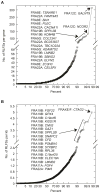Fragility Extraordinaire: Unsolved Mysteries of Chromosome Fragile Sites
- PMID: 29357071
- PMCID: PMC6055930
- DOI: 10.1007/978-981-10-6955-0_21
Fragility Extraordinaire: Unsolved Mysteries of Chromosome Fragile Sites
Abstract
Chromosome fragile sites are a fascinating cytogenetic phenomenon now widely implicated in a slew of human diseases ranging from neurological disorders to cancer. Yet, the paths leading to these revelations were far from direct, and the number of fragile sites that have been molecularly cloned with known disease-associated genes remains modest. Moreover, as more fragile sites were being discovered, research interests in some of the earliest discovered fragile sites ebbed away, leaving a number of unsolved mysteries in chromosome biology. In this review we attempt to recount some of the early discoveries of fragile sites and highlight those phenomena that have eluded intense scrutiny but remain extremely relevant in our understanding of the mechanisms of chromosome fragility. We then survey the literature for disease association for a comprehensive list of fragile sites. We also review recent studies addressing the underlying cause of chromosome fragility while highlighting some ongoing debates. We report an observed enrichment for R-loop forming sequences in fragile site-associated genes than genomic average. Finally, we will leave the reader with some lingering questions to provoke discussion and inspire further scientific inquiries.
Keywords: Aphidicolin; Cancer; Chromosome fragility; Common and rare fragile sites; DNA double-strand breaks; DNA replication stress; Folate stress; Neurological disorders; R-loops.
Figures


Similar articles
-
Oncogenes create a unique landscape of fragile sites.Nat Commun. 2015 May 11;6:7094. doi: 10.1038/ncomms8094. Nat Commun. 2015. PMID: 25959793
-
Common fragile genes.Eur J Histochem. 2004;48(1):29-36. Eur J Histochem. 2004. PMID: 15145773 Review.
-
Human chromosome fragility.Biochim Biophys Acta. 2008 Jan;1779(1):3-16. doi: 10.1016/j.bbagrm.2007.10.005. Epub 2007 Dec 3. Biochim Biophys Acta. 2008. PMID: 18078840 Review.
-
Low-frequency common fragile sites: link to neuropsychiatric disorders?Cancer Lett. 2006 Jan 28;232(1):58-69. doi: 10.1016/j.canlet.2005.08.033. Epub 2005 Nov 17. Cancer Lett. 2006. PMID: 16298041 Review.
-
Common fragile sites as targets for chromosome rearrangements.DNA Repair (Amst). 2006 Sep 8;5(9-10):1126-35. doi: 10.1016/j.dnarep.2006.05.010. Epub 2006 Jun 27. DNA Repair (Amst). 2006. PMID: 16807141 Review.
Cited by
-
DNA Replication Stress and Chromosomal Instability: Dangerous Liaisons.Genes (Basel). 2020 Jun 10;11(6):642. doi: 10.3390/genes11060642. Genes (Basel). 2020. PMID: 32532049 Free PMC article. Review.
-
Fragile sites, chromosomal lesions, tandem repeats, and disease.Front Genet. 2022 Nov 17;13:985975. doi: 10.3389/fgene.2022.985975. eCollection 2022. Front Genet. 2022. PMID: 36468036 Free PMC article. Review.
-
A Double Jeopardy: Loss of FMRP Results in DSB and Down-regulated DNA Repair.21 Century Pathol. 2022;2(5):125. Epub 2022 Oct 17. 21 Century Pathol. 2022. PMID: 36688938 Free PMC article.
-
Common Threads: Aphidicolin-Inducible and Folate-Sensitive Fragile Sites in the Human Genome.Front Genet. 2021 Sep 8;12:708860. doi: 10.3389/fgene.2021.708860. eCollection 2021. Front Genet. 2021. PMID: 34567068 Free PMC article. Review.
-
Replication initiation: Implications in genome integrity.DNA Repair (Amst). 2021 Jul;103:103131. doi: 10.1016/j.dnarep.2021.103131. Epub 2021 May 11. DNA Repair (Amst). 2021. PMID: 33992866 Free PMC article. Review.
References
-
- Amarose AP, Huttenlocher PR, Sprudzs RM, Laitsch TJ, Pettenati MJ. A heritable fragile 12q24.13 segregating in a family with the fragile X chromosome. Hum Genet. 1987;75:4–6. - PubMed
-
- Arlt MF, Miller DE, Beer DG, Glover TW. Molecular characterization of FRAXB and comparative common fragile site instability in cancer cells. Genes Chromosom Cancer. 2002;33:82–92. - PubMed
-
- Arlt MF, Durkin SG, Ragland RL, Glover TW. Common fragile sites as targets for chromosome rearrangements. DNA Repair. 2006;5:1126–1135. - PubMed
Publication types
MeSH terms
Grants and funding
LinkOut - more resources
Full Text Sources
Other Literature Sources

